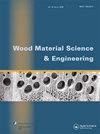竹-云杉-松木胶合层合板的声学特性
IF 2.1
3区 农林科学
Q1 MATERIALS SCIENCE, PAPER & WOOD
引用次数: 0
摘要
摘要噪声污染已成为一个全球性问题,对人类健康产生了负面影响。本文首次采用阻抗管法测定了胶合竹(glubam)和云杉-松杉(SPF)的吸声指数和吸声系数。还研究了含水量对这些材料声学性能的影响。实验结果表明,对于厚条胶和SPF,含水量越高,吸声指数越高,但吸声系数越低。然而,含水量对薄条形胶的声学性能没有明显影响。通过与其他材料的比较可以发现,葡聚糖和SPF具有相对较高的正入射透射损耗,但吸收系数和降噪系数较低。Glubam表现出与SPF相似但甚至更好的隔音性能,这证实了使用Glubam作为木材材料替代品的可能性。此外,建立了有限元模型来模拟阻抗管中声音传输损耗的测量。然后使用有限元模型进行了一些参数研究,以证明增加厚度、使用复合材料和双层面板对提高材料隔音性能的有效性。本文章由计算机程序翻译,如有差异,请以英文原文为准。
Acoustic properties of glued laminated bamboo and spruce-pine-fir
Abstract Noise pollution has become a worldwide issue, which has a negative effect on human health. The sound reduction index and absorption coefficient of glued laminated bamboo (glubam) and spruce-pine-fir (SPF) were firstly measured in this study by using the impedance tube method. The effect of moisture content on the acoustic performance of these materials was also investigated. Experimental results revealed that for thick-strip glubam and SPF, the higher moisture content, the higher sound reduction index but lower sound absorption coefficient. However, moisture content does not have an obvious effect on acoustic properties of thin-strip glubam. By comparing with other materials, it can be found that glubam and SPF have relatively high normal-incidence transmission loss but low absorption coefficient and noise reduction coefficient. Glubam shows the similar but even better acoustic insulation performance than SPF, which confirms the possibility of using glubam as an alternative of wood materials. Moreover, a finite element model was built up to simulate the measurement of sound transmission loss in an impedance tube. Some parametric studies were then conducted using the finite element model to prove the effectiveness of increasing thickness, using composites and double-layer panels on improving the soundproof performance of materials.
求助全文
通过发布文献求助,成功后即可免费获取论文全文。
去求助
来源期刊

Wood Material Science & Engineering
Materials Science-General Materials Science
CiteScore
3.90
自引率
13.60%
发文量
131
审稿时长
79 days
期刊介绍:
Wood Material Science and Engineering is a multidisciplinary and international journal with the aim to serve at the forefront of the wood science and technology field. The journal publishes original articles on basic and applied research dealing with:
-Wood material science with emphasis on: water-wood relations, wood durability, wood modification, wood mechanics, wood composites, engineered wood products, energy conversion and eco-efficient wood based products.
-Wood engineering, i.e. the application of the wood material science to designing, processing and manufacturing of forest products and the use of machines and processes for these products. Products of concern are biofuels, sawn wood and further refined products such as structural elements, interior fittings and furnishings. In this aspect the link between the nature of the wood material and the properties of the final wood products in-service and its impact on the environment is of outmost importance.
High quality review papers may also be accepted but the topic should be discussed with the editor before submission.
 求助内容:
求助内容: 应助结果提醒方式:
应助结果提醒方式:


